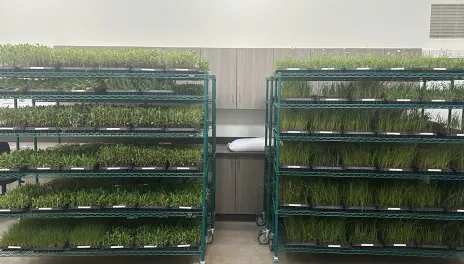Hettinger Research Extension Center supports building of Theodore Roosevelt Presidential Library through Native Plant Project
Theodore Roosevelt is remembered as the “conservation president.” As president, he began the United States Forest Service which helped establish 150 national forests, 55 federal bird and game reserves, and five national parks. Roosevelt’s conservation efforts protected 230 million acres of public land.
The 26th U.S. President came to North Dakota to hunt in the 1880s and would spend a lot of time in the Badlands of the state, stoking his love for environmental causes. Roosevelt considered Elkhorn Ranch, located north of Medora, North Dakota, his home ranch.
His environmental passion and legacy are reflected in the Native Plants Project being established as part of the Theodore Roosevelt Presidential Library which is being built west of Medora near the Theodore Roosevelt National Park. It’s a project sponsored by the library, that collaborates with North Dakota State University and Resources Environmental Solutions (RES) to help restore and enhance the ecological diversity of the surrounding landscape and provide seeds for landscaping and construction of the library's living native prairie roof.
Ben Geaumont, range and wildlife scientist at the Hettinger Research Extension Center (HREC), started working on the project in 2022. Using seeds collected from within 50 miles of the library by RES personnel, Geaumont propagated many native species into seedlings. These seedlings will be the source of additional seeds.
The roof construction will require a large amount of native seed, and though most of it will be collected from the wild by RES and volunteers, for certain species more seed is needed than could be collected in the wild. As a result, nursery beds were created to be used for seed production. The HREC received its first shipment of plants from RES in spring 2023 with a second cohort of plants arriving in 2024 for a total of over 60,000 seedlings belonging to over 30 native forb and grass species.
“We spend a lot of time hand weeding, and because it seldom rains in western North Dakota, keeping water on the young plants has been critical,” Geaumont says.

Although the plantings are relatively new, many species are already producing seed especially those planted in 2023. The seed grown at the HREC will be used by RES to grow several hundred thousand seedlings to be placed on the roof beginning in spring 2025.
“While the project will be seen by many tourists at the Roosevelt Library and help push the message of grassland conservation, it is the potential impact the project could have on North Dakota’s agriculture and landscape on a larger scale that excites me,” Geaumont says.
The biodiversity of the North Dakota grasslands has significantly decreased over the past few decades as grasslands have been converted into farmland, invaded by non-native species and heavily grazed by cattle. Grassland restoration is fundamental to long-term grassland conservation and the importance of local native ecotypes to restoration is still not fully understood though their importance to ecological functioning is slowly being realized. The establishment of the Native Plant Project and commitment on behalf of the Presidential Library is a huge step towards developing local native ecotypes for many important plant species found in the western Dakotas.
“My goal is to have more native seeds from multiple species from the western Dakotas and Montana,” Geaumont says. “Preserving this genetic material, and getting it to the point, where it’s not just at the library but available for use on restoration projects throughout the west would be great. The demand for native seed and local ecotypes is expanding and overall may provide an opportunity for farmers as well.”
While Geaumont’s long-term focus is on grassland conservation across the Dakotas and eventually bringing some of this seed into production, the immediate goal is to do all he and his team can do to maximize seed production on the current nursery plots because once the roof is complete there are still multiple gardens and restoration projects to be completed at the library site that will require a seed source well into the future.
“Dr. Ben Geaumont’s dedication to the Native Plant Project showcases the profound impact of hands-on stewardship,” said Amy McCann, community relations director for the Roosevelt Library. “His tireless efforts – planting, weeding, harvesting – bring our restoration vision to life. By collaborating with the library and contractors, he is not only growing local genetic material that is not commercially available elsewhere but also cultivating a lasting legacy of sustainability and ecological balance.”
For more information
Theodore Roosevelt Presidential Library Native Plants Project
Ben Geaumont, 701-567-4323
